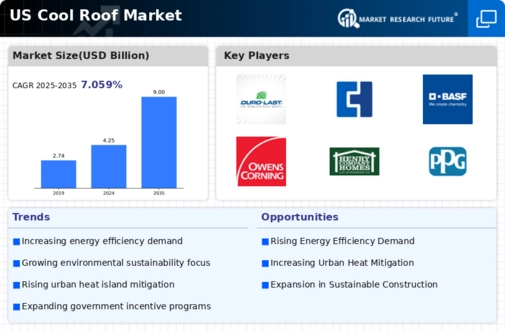The cool roof coatings market is currently characterized by a dynamic competitive landscape, driven by increasing awareness of energy efficiency and sustainability. Major players such as GAF (US), CertainTeed (US), and Sherwin-Williams (US) are actively positioning themselves through innovation and strategic partnerships. GAF (US), for instance, emphasizes its commitment to sustainability by developing products that not only enhance energy efficiency but also contribute to LEED certification. This focus on eco-friendly solutions appears to resonate well with both commercial and residential sectors, thereby shaping a competitive environment that prioritizes environmental responsibility alongside performance.
In terms of business tactics, companies are increasingly localizing manufacturing to reduce lead times and optimize supply chains. The market structure is moderately fragmented, with several key players holding substantial market shares while also facing competition from smaller, niche manufacturers. This fragmentation allows for a diverse range of products and innovations, which collectively influence market dynamics and consumer choices.
In November 2025, CertainTeed (US) announced the launch of a new line of reflective roof coatings designed specifically for urban environments. This strategic move is significant as it addresses the urban heat island effect, a growing concern in metropolitan areas. By targeting this specific issue, CertainTeed (US) not only enhances its product portfolio but also positions itself as a leader in addressing urban sustainability challenges, potentially increasing its market share in densely populated regions.
In October 2025, Sherwin-Williams (US) expanded its distribution network by partnering with several regional suppliers to enhance product availability. This action is crucial as it allows Sherwin-Williams (US) to penetrate new markets more effectively and respond to local demand fluctuations. The partnership strategy may also facilitate quicker delivery times, thereby improving customer satisfaction and loyalty in a competitive landscape.
In September 2025, GAF (US) entered into a collaboration with a technology firm to integrate AI-driven analytics into its product development process. This initiative is indicative of a broader trend towards digital transformation within the industry. By leveraging AI, GAF (US) aims to enhance product performance and customer insights, which could lead to more tailored solutions and a stronger competitive edge.
As of December 2025, the competitive trends in the cool roof coatings market are increasingly defined by digitalization, sustainability, and technological integration. Strategic alliances are becoming more prevalent, allowing companies to pool resources and expertise to innovate more rapidly. The shift from price-based competition to a focus on innovation and supply chain reliability is evident, suggesting that future differentiation will hinge on the ability to deliver advanced, sustainable solutions that meet evolving consumer demands.






















Leave a Comment